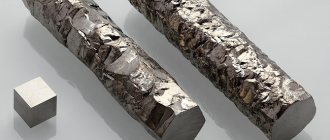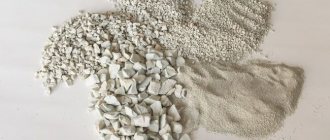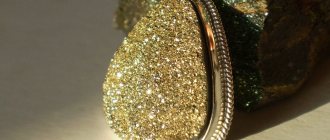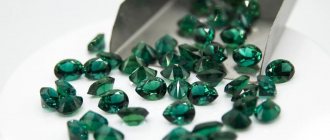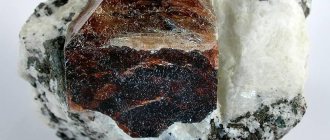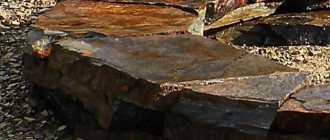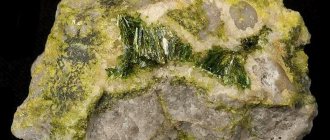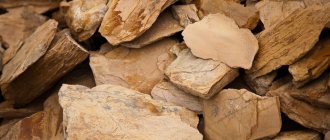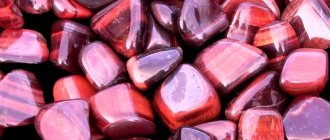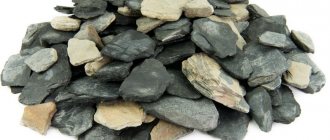Among the many creations of nature, argillite stone deserves special attention - a stone-like rock that is little known to fans of expensive precious products, but is widely used in the construction industry. Despite the fact that the mineral is not of particular value to jewelers, the history of its origin is interesting and closely connected with the culture of the Indians, and the stone itself has healing and mystical properties.
Origin of mudstone
Argillite photo Argillite is a rock that is formed as a result of clay drying, compaction, and physical fusion in the layers of the earth's crust.
There are two scientific terms at play here.
- Diagenesis is the transformation of loose masses into sedimentary rocks.
- Epigenesis is the secondary transformation and saturation of rock to the final mineral.
As a result of the combination of these two processes, argillite is formed, which is now increasingly being used in a variety of fields.
Interesting Facts
The most common use of mudstone was by the Indians. From the red variety they made paint which they applied to the body. The Indians also used these stones for rituals. Most often, minerals served to create a connection with the world of the dead.
This rock was used to create primitive weapons. The stronger samples were used to make spear points. It was believed that this material added confidence to the fighter, making him more courageous and also cautious during battle.
Argillite rock: characteristics and properties
Argillite stone photo
The name argillite was assigned to the mineral not by chance. Like many stones known since ancient times, it has a Greek etymology, that is, the word “argillite” is formed from two words: “argillos” (Greek argillos) - clay and “litos” - stone.
It turns out to be a “clay stone”. Experts often say that it is a type of shale clay with a stone-like appearance.
There are other names for argillite, here are some:
- Hailite;
- mudstone;
- zebra stone.
Such names are found in the scientific literature, but there are also folk ones, for example, mud stone.
The color can be different: from dark, almost black (soft shine) to amber, whitish (resinous shine).
You can immediately determine the average characteristics of an argillite stone.
Physical characteristics of mudstone:
- The color is predominantly dark gray, but there are examples of light, black, pinkish, greenish or brown shades.
- The density of argillite is 1.3–2.6 g/cm3.
- The surface is smooth and shiny.
- Hardness - 3.5–4.
- Structure: cryptocrystalline; according to the content of clay particles - clayey.
- The fracture is uneven.
- The texture is homogeneous, thin-layered. These are quite low values, which explain why argillite is so rarely used in jewelry.
Of course, the problem is not that it is ugly (on the contrary, it looks very nice), but that it is difficult to process: it crumbles, crumbles, and does not fit well into frames.
As a result, the decoration becomes short-lived. The jeweler has to spend a lot of labor, but the result is a product with a low cost.
Therefore, it is often said that argillite is indirectly related to jewelry.
The photo shows that the stone is actually quite beautiful; it is often confused with either agate or amber.
How to distinguish a real stone from a fake
Visually, untreated mudstone is indistinguishable from siltstone. In the field, they are ground and the rock is determined by its grain size. When crushing clay stone, fragments with a sharp edge are formed, there are no rounded grains of sand.
A jeweler or gemologist (an expert in evaluating stones) can determine the type of argillite in finished products and confirm its naturalness. At home, you can only distinguish a mineral from a fake that is not coated with varnish or oil. It smells like clay and is scratched by a knife.
What is mudstone?
Mudstone rock
There is much debate about mudstone, especially regarding its origin.
Researchers agree on one thing: mudstone is fossilized clay.
Moreover, the solidification process took many millions of years under the influence of high temperatures.
That is why it was not so easy to obtain the mineral under artificial conditions.
Compaction and removal of moisture is just one of the conditions for the formation of stone.
There are mechanical impurities, most often of a silicon nature, we are talking about sand.
The question of the distribution of argillite often arises. It lies in layers and can be mined on a large scale; the question is only about the feasibility of the event.
Although the mineral is essentially clay, it has lost the properties of this substance: it does not get wet, does not absorb moisture, and does not become soft.
For this reason, mudstone (argillos) is well preserved and stored both in the ground and in mined form.
Argillite in the ancient world
As already mentioned, the mineral has been known since ancient times.
Its processing began at a time when people had minimal knowledge and means of processing stones. Near Alaska there is an archipelago called the Queen Charlotte Islands. The Haida tribe lived there. It is also noted that this is an extensive mudstone deposit.
The local mineral became available because the soil pressed it to the surface as an extremely hard substance. Of course, the Indians did not develop the breed, but only collected it in accessible places.
The Indians became famous for processing black and red mudstone; it was used to create the so-called peace pipes for smoking.
This is where one of the side names came from – hailite, mentioned earlier. The fact is that the locals succeeded in processing this material.
Many items were found, some of which received high marks from experts.
First of all, these are ritual attributes, amulets, jewelry, household appliances, fixtures and more.
Scientists believe that these tribes are not only the ancestors, but also the first processors of argillite.
Of course, in the modern world, not such heights have been achieved, technology continues and develops, but everywhere there is a beginning, a source.
Products made from argillite are currently stored in museums and private collections.
They cost impressive sums, despite the fact that the material itself does not have any special value. It's ancient history now.
Varieties
Argillite is divided into several types, each of which differs in color and composition:
- Zebra stone. A characteristic feature is the alternation of dark and light stripes in color.
- Mudstone is a variety that is resistant to abrasion and damage.
- Hailite is a dark gray mineral found in British Columbia.
- Catlinite, or pipe stone, was used to make peace pipes.
- Carbonaceous argillite is a mineral containing clay and tiny particles of coal.
Carbonaceous mudstone
Application of mudstone
The structure of mudstone is such that its properties are rarely extolled.
They are at an average level, but, admittedly, quite sufficient to achieve some goals.
For example, for making crafts, some jewelry, coasters, candlesticks, etc.
It often happens that the mudstone is very beautiful, but there is no consistency. In a number of other cases, the material does not have a beautiful color or pleasant shine at all.
Low hardness makes it difficult to process even the best raw materials. There are always many problems here, the main one being that the density is lower than required.
The substance can be ground into dust and rubbed on the body, as the Indians did to create a protective coloring. In this case, the material acts as a coloring agent.
And in fact, its coloring ability is excellent: the paint is easy to apply, does not come off for a long time, is waterproof, and has a long-lasting rich color.
This mineral is also used in industry. It is added to the mixture to obtain an astringent effect.
It turns out that when high temperatures are reached and softened, this material has high astringent properties.
Crushed stone material is also used, but in construction. The pieces are used to decorate interiors.
The grated material is applied to the wall, forming a rough texture that looks beautiful and shines. Currently, this method is used quite often.
It is important that argillite is completely safe for health and does not contain allergens. Therefore, you can wear amulets from it without fear of harming yourself.
Various decorations are made from this stone: artists note that drawings are placed very easily and harmoniously on such a soft surface.
To enhance the effect, the top layers are impregnated with a specialized composition, resulting in additional softness. Products are most often varnished - this way they last longer and look presentable.
On the other hand, you can increasingly see argillite jewelry on girls. How can this be, since the stone is not intended for jewelry?
The fact is that modern technologies make it possible to process the mineral, and they wear it because it has excellent magical properties, which will be discussed later.
The healing properties of argillite
The stone has argillite and healing properties. Best suited for people who suffer from diseases of the genitourinary system.
It is highly recommended for men, as it stimulates potency and restores lost function. Has a beneficial effect on the pancreas.
It will protect a healthy person from dangerous diseases. Restores the liver. Recommended for people who have problems with alcohol.
The stone not only strengthens and restores the body, but also helps reduce the craving for alcohol.
The magical properties of argillite
When generalizing the properties of argillite and giving its detailed description, sometimes they forget to talk about the otherworldly, that is, magical properties of the argillite stone.
And this, of course, should be given considerable importance. To begin with, talismans made from this mineral are most effective if brought from Canada. The Indians who lived there learned ancient truths, which is why these amulets are most valued.
O enhances prophetic abilities.
First of all, the properties of argillite are such that it protects the owner from the effects of dark energy, that is, from evil eyes, love spells, etc.
If you are at home, then the stone will protect the entire house; evil spirits and bad people will not enter here.
An ordinary person may have a premonition of danger - this is how the talisman saves from misfortune.
In addition, often people wearing this stone discover healing abilities in themselves: they touch a person’s head, and the pain goes away, etc. The stone soothes and protects.
It is best worn by extroverts, but introverted people should not even try it, as the results can be very disappointing: apathy, depression.
Argillite stone: who suits it according to their zodiac sign
Astrologers recommend the stone for Gemini, as well as other air signs. This happens because these people suffer most from dark forces and attract negative energy to themselves, being donors. The stone is also suitable for Cancers and Scorpios; first of all, it will help in family matters.
But it is not recommended for Pisces, since most often these people are too self-absorbed to be able to advise them on calming talismans. Pisces don’t need a talisman at all, since they are the most careful people in the world.
Argillite will not give anything good to earth signs; they wear it only in case of illness, sometimes it helps a lot. It is highly not recommended for fire signs to wear a pebble; it will cause depression, anxiety, spleen, unreasonable fear, and depression. In addition, health problems may begin. Lithotherapists advise them not to even try to wear jewelry with this mineral.
As you can see, the pebble brings success and health to some people, and anxiety and worry to others. We can sum it up by saying that it is always better to consult a professional before using this or any other amulet. The same can be said for talismans of various properties.
The magical sciences are too complex to be explored alone. Beware of fakes, as surrogate argillite may not give any effect at all, the money will be wasted. It is best to trust trusted jewelry stores or order the product online.
Horoscope
According to astrologers, argillite is subordinate to the dark Moon during the last phase and transfers its power to its owner. He is the patron of the zodiac signs of the verses of Air (Libra, Aquarius, Gemini) and Water (Cancer, Scorpio, Pisces), his action enhances and helps in the development of innate talents and hidden abilities, up to witchcraft, prophecy and fortune telling.
Representatives of the elements of the Earth (Taurus, Capricorn and Virgo) will also experience the power of the stone if they wear it during the waxing period of the Moon until the full moon.
Argillite is contraindicated for signs of the element of Fire (Leo, Sagittarius, Aries). Ignoring the prohibition and wearing the mineral as a talisman or decoration can attract trouble, illness and misfortune to representatives of these signs.

